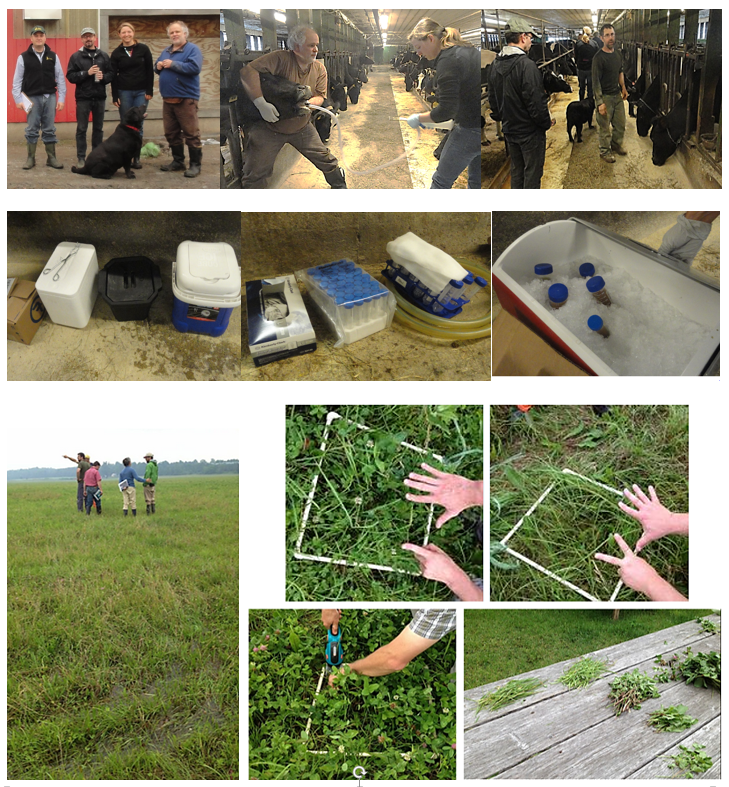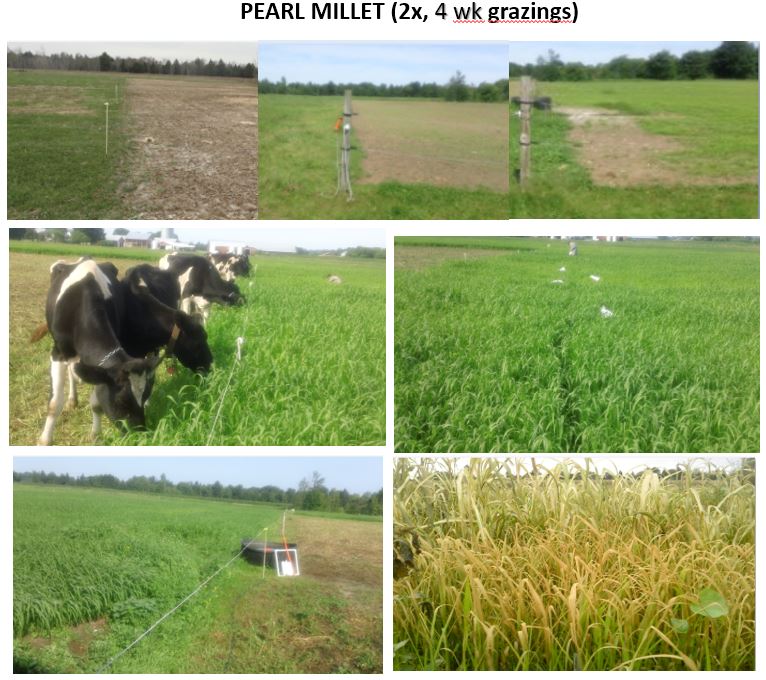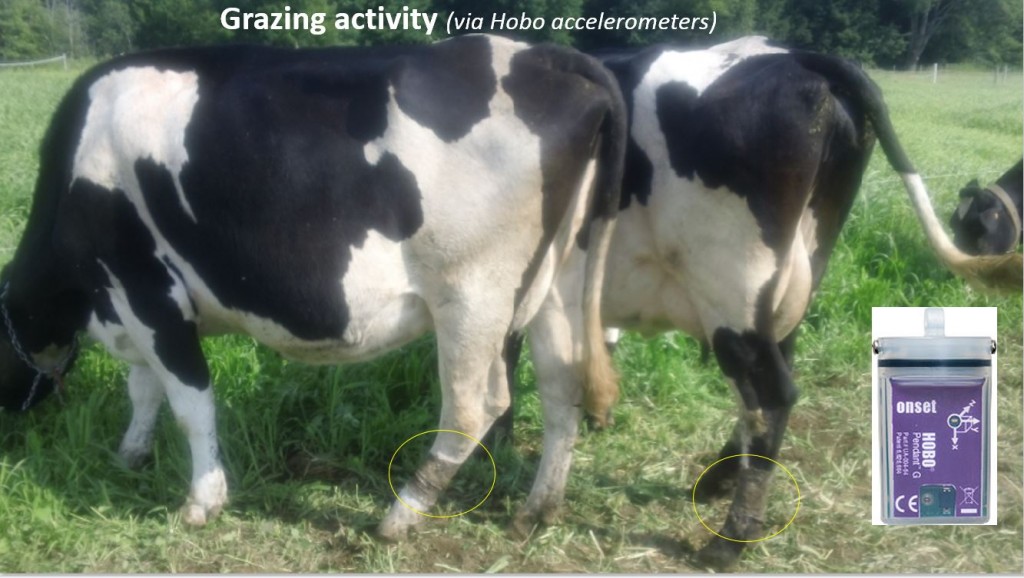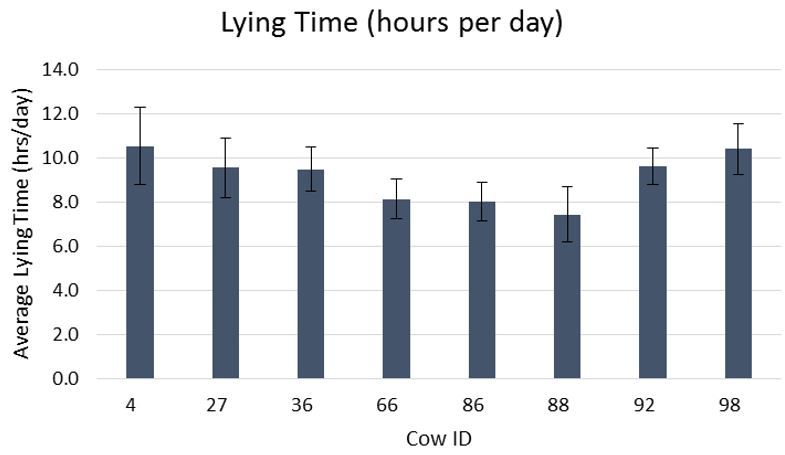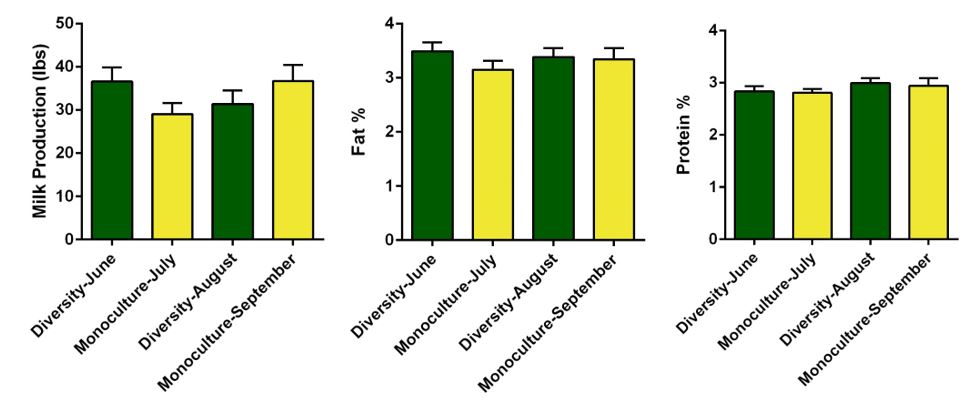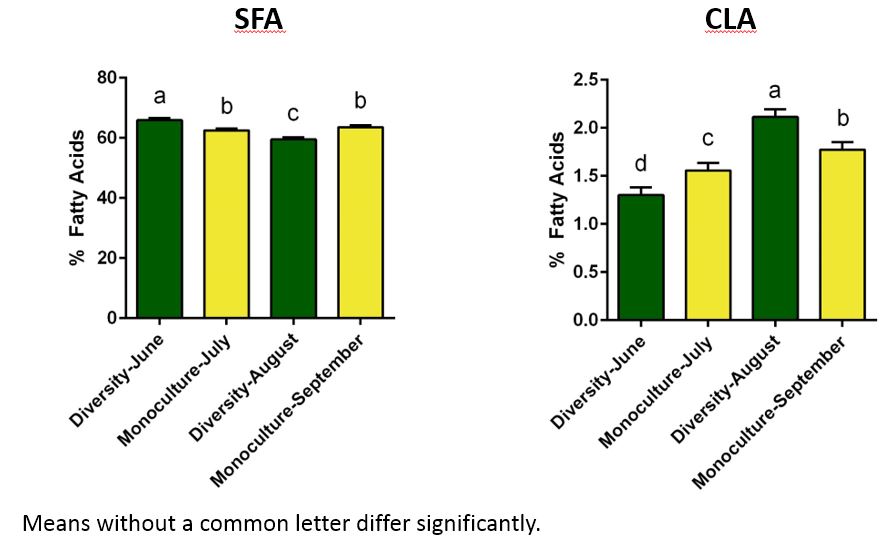Final Report for ONE14-196
Project Information
Our project team at Choiniere Family Farm in Highgate Vermont, studied the ability to estimate forage intake rates and assessed cow’s productivity and behavior over three diets: winter feed (balage and grain), pearl millet and diverse cool season pastures, adapted to the Northeastern United States. Understanding the response of ruminant and environmental microbial communities to specific management practices is critical to optimizing farm productivity and quality, enhancing ecosystem-based management of farms and agricultural landscapes. We concluded that pastures managed for increasing diet diversity can maintain dairy productivity (yield, fat and protein percentages), enhance milk fatty acids, (lowering saturated fats and omega 6/omega 3 ratios), and livestock well-being, and human health. When tested for grazing behavior, animals showed the same level of activity between diverse pastures and monoculture.
Introduction:
Milk quality and cow’s wellbeing depends --among others- upon a careful integrated observance and performance of production factors such as, soil health, diverse quality diet, rumen microbiome, and grazing activity. Dairy farms support numerous microbial communities, including mutually beneficial relationships between dairy cattle and their microbial symbionts (rumen microbiota). These cellulolytic bacteria break down plant materials providing cows’ a source of energy and nutrients. Thereby, understanding the response of ruminant and environmental microbial communities to specific management practices is critical both, to optimizing farm productivity and enhancing ecosystem-based management.
In 2013, our research team collaborated on a study focused on assessing whether ecological habitat disruption is associated with milk quality and grazing behavior on an ongoing long-term research to determine how biodiversity changes affects livestock well-being, health, and productivity. In general, common knowledge suggests that, managing for increased biological diversity and for minimally disturbed soils, adequate access to a diverse high quality forage mix, and clean water, positively contributes to improved livestock productivity, health and well-being.
We wanted to understand how different diets can affect grazing behavior and in turn, how the relationship between grazing time and diet alters forages, rumination activity, rumen pH and health, milk composition and productivity.
In our study at Choiniere Family Farm, we randomly selected eight-second and third lactation cows in relatively close milk production levels, with days in milk ranging from 50 to 90 days and milk fat between 2.8 and 3.6% which were offered three different diet treatments: (1) winter feed (balage and grain), (2) diverse cool season forages and (3) pearl millet summer annual pasture. Choiniere’s farm has been certified organic since 2005 and it has pastures that have not been plowed for over 25 years.
We monitored grazing behavior and forage intakes in real-time hoping to optimize forage utilization, rumen activity, and milk composition; (B) improve productivity, milk quality, reduce costs, and increase net farm income.
The goal was to test relationships between ecological diversity and sustainable management grazing practices in pasture-based dairy production systems in this farm. Our overarching questions were, (1) how different diets affect rumination activity, rumen pH and health, milk composition and productivity? (2) evaluate the relationships between grazing time and diet grazing behavior between diets.
Our findings revealed that diverse cool season forages and warm season forage did not differ in soils, forage yield, milk production, milk protein and fat percent. However, we found differences in percent of soil cover, adequate manure distribution and trampling, soil moisture and grazing at a mature stage. Conjugated Linoleic acid (CLA) and Omega-3 fatty acids in milk were higher (significantly different) in cows that grazed exclusively on diverse pastures. Saturated fatty acids and omega-6/omega-3 ratios in milk were lowest when cows grazed on diverse pastures. Warm season forages were instrumental to cope with the summer slump loss of forage production and milk production decline. We also found differences in cow’s lying time (hours per day); the average lying time was 9.2 hours per day where, higher producing cows had longer average lying times. We found no effect on pasture type o lying time.
We anticipate that this work can explain the importance of maintaining healthy and diverse pasture ecosystems in Vermont dairy farms. By optimizing these production parameters, pasture-based dairy farmers may simultaneously, improve livestock diet, as well as, health and well-being, reduce farm costs, environmental impacts, and produce the healthy dairy products society is demanding.
The main objectives of this project were:
(1) How different diets affect rumination activity, milk composition, health and productivity
(2) Evaluate the relationships in grazing activity to determine potential differences in lying behavior among cows and different diets.
Cooperators
Research
This study was placed at Choiniere (Organic Dairy) Family Farm in Highgate VT. Choiniere farm has been certified organic since 2005 and it has pastures that have not been plowed for over 25 years. Before the experiment began, we learned that Choiniere Farm breeds year-round. Cowherd at Choiniere Family Farm is certified organic and do not receive any medicinal treatment other than nutrition consisting mostly of fresh forages and winter balage supplementation. In May and October we collected balage samples (diet 1) to test for feed quality and fatty acids. Between June and September, we carried out weekly forage species diversity, pasture biology, botanical composition, yield and quality sampling of diets (2) diverse cool season forages and (3) pearl millet. We collected soil and forage samples where cows grazed, between May and November of 2014.
As a way to lower risks related to illness or pregnancies that could affect statistical viability of the experiment, we randomly selected eight-second and third lactation cows in relatively close milk production levels, with days in milk ranging from 50 to 90 days and milk fat between 2.8 and 3.6% which were offered three different diet treatments: (1) winter feed (balage and diverse cool season forages), (2) diverse cool season forages and (3) pearl millet summer annual pasture.
We used single-group repeated measures design, where eight cows strip grazed, diverse cool-season forages pastures (trt 1) and pearl millet (trt 2) and indoor feed (balage). Cows stayed for approximately two-alternated four-week periods on each diet respectively, in order to document changes. Samples (soils, forage, rumen and milk) were taken weekly. Grazing activity was measured for five different two-week periods during the course of the study.
Soil Assessment: Soil samples from each of the pastures where cows grazed were taken. Each sample was obtained by combining 15 sub-samples in a clean bucket. After mixing it, two sub-samples were taken from the mix, and placed in two sealed identified plastic bags, and stored inside a refrigerated cooler to be shipped overnight to two different soil labs, Earthfort in Oregon and Woods End in Maine. Earthfort analyzed relationships and dynamics of soil life groups such as, microbes, fungi, nematodes, protozoa, and bacteria. By using this test focused on biological measurement, we were able to compare soil life between highly tilled versus unplowed soils. Woods End performs regular chemical analyses, evaluating the quality of soil carbon content and respiration as a proxy for microbial activity, estimates N and P mineralization potential and nutrients likely to be plant relevant.
Forage Assessment: 1) Forage samples were taken in three stages. First, preceding forage sampling, we randomly threw a 0.1 m2 quadrant 25 to 35 times within each plot or study site to rank the three most predominant forage species using the Dry Weight Rank Method. Second, with the quadrant on the ground, we monitored pasture and site ecology by using a pasture-soil biology monitoring technique. This technique helps quantifying soil-pasture ecosystem functions related to mineral and water cycle and community dynamics by randomly recording data from 25 to 100 points along a transect in the representative area of the paddock in study. These data points provide insights for management improvements by evaluating environmental indicators. These two previous methods were not invasive and did not damaged forages. 2) Botanical composition: Forage samples were collected along the study area, using an electric clipper at soil surface to trim within the quadrant to the estimated grazing height at 3m intervals. All samples were combined, and a representative subsample was separated into botanical components (grasses, legumes, forbs or dead material) to determine botanical composition. The fractions were bagged, identified and weighed fresh, then dried at 65°C for 48 h to determine the DM/A proportions forage yield (Kg/hectare) of the different botanical components. 3) Forage Quality: Grab samples were randomly collected from each plot before grazing, for analysis of forage quality factors (crude protein, acid detergent fiber, neutral detergent fiber, total digestible nutrients, fatty acid content, and net energy lactation). Samples were dried at 65°C for 48 h, milled and sent to UVM, NW Crop and Soil NIH Lab to be analyzed. 4) Pre- and post- grazing forage sward: A Filip’s folding plate meter (Jenquip, Fielding, New Zealand) was used to estimate pre- and post-grazing pasture mass by use of standard Jenquip equation for pastures with reasonable consistent rainfall. We used a standard equation for all pastures composed of a grass – legume mixture. For diverse pastures, we calibrated cuts to create individual standardized equations. Each of these calibration cuts were weighed fresh then oven dried at 65°C for 48 h and re-weighed to determine DM content. The calibration curve was calculated using the calibration cuts. Pre-and post-grazing plate meter measurements will then be used to calculate estimated herd daily dry matter intake. To determine the pre-grazing pasture mass of all pastures, the folding plate meter will collect plate meter data from a pasture within 24 hr. prior to grazing. Plate meter measurements will then be taken at every 2 paces on a diagonal of the paddock, and further measurements will be taken on the opposing diagonal. Plate meter data collection will be repeated after grazing for 24 h to determine the postgrazing pasture mass (kg DM per hectare).
Grazing activity data loggers
Eight cows were enrolled from May to October 2014 in a study of the impact of pasture species diversity on milk composition and quality. A Hobo Pendant data logger was attached above the right hind ankle (metatarsus) to each cow for 5 different 2 week periods during the course of this study. The loggers were attached using flexible bandage material and white medical tape. The loggers were removed after 2 weeks and cows were given at least one week before reattaching a data logger. Data was downloaded from the loggers using the Hobo USB Base Station data port connected to a personal computer and data was managed using Hoboware Pro software (Onset Computer Corporation). Data was exported to Microsoft Excel spreadsheets and lying behavior was summarized by day for each cow using SAS software and a set of previously published algorithms. Outputs from the activity data for each cow included daily lying and standing time, number of lying and standing bouts, and average duration of the daily lying and standing bouts. These data were then used to create averages for periods of time the cows were grazed on either a diverse pasture of a monoculture of millet. A minimum of 3 days data was compiled into the average for each feed source, and during 2 monitoring periods activity was recorded during a transition from one forage source to another forage source. Pre- and post-transition periods were defined, respectively, as the last 4 days grazing one type of pasture and the first 4 days grazing another pasture source.
Feed samples: Feed composites were analyzed for dry matter (105°C for 8 h), for chemical composition, and for fatty acid content and profile. For the latter, a subset of the feed composites were dried at 55°C in a forced-air oven, ground to pass through the 1-mm screen of a Wiley mill. Fatty acid content and profile were analyzed using a modified version of the direct transesterification method. Fatty acids were transesterified directly using 2% H2SO4/methanol and a combination of acetone and toluene (2 h at 70°C). Samples were subsequently purified using a mixture of charcoal and silica gel. The fatty acid profiles (as fatty acid methyl esters, FAME) were analyzed by gas liquid chromatography (GLC) with flame ionization detection (FID; Shimadzu, Kyoto, Japan) using a highly polar 100 m fused‐silica capillary column. FAME were identified by comparison of retention times with known FAME standards. Total fatty acid content was determined using C13:0 as an internal standard.
Milk samples: One subset of weighted composite milk samples from each cow was be analyzed for milk components (fat, true protein, lactose, total solids, and milk urea N) by Lancaster DHIA Labs (Lancaster, PA) using mid-infrared technology. The second subset was analyzed for fatty acid content and profile using established methods. Briefly, cream is separated from milk composite samples by centrifugation. After extraction of total lipids from the cream using a mixture of n-hexane/isopropanol (3:2 v/v), FAME were prepared with 0.5 M NaOCH3/methanol (5 min at room temperature). Total fatty acid profile, covering circa 80 fatty acids in the range of C4:0 to C26:0, determined by GLC‐FID as described above. The short-chain FAME are corrected for mass discrepancy using correction factors. Fatty acid yield (g/d) is determined by multiplying the percentage of each fatty acid by milk fat yield and by 0.86, a value corresponding approximately to the percentage of fatty acids in triacylglycerides.
Rumen Health: Eight sentinel cows had rumen fluid extracted by the project team to facilitate measurement of critical rumen health outcomes related to three diet intakes. Samples included rumen pH, rumen microbial diversity, and consumed forage composition.
Rumen samples were collected weekly. Initially, we planned to fistulate six cows’ however the Northeast Organic Farmers Association (NOFA) advised against the method because of the stress (and other health complications) this method could impose to cows which in turn, could result in the loss of their organic status. Instead, we used a speculum --a 16 inch metal tube that is secured by an operator in the cow’s mouth while a second operator inserts a plastic flexible transparent hose through the speculum into cow’s stomach. The second operator pumps and extracts rumen fluid. To support rumen data, we planned to install rumination collars to measure rumination activity. However, because of schedule difficulties and high demand, the company responsible for installing these collars could only do it later in the season, which would inviabilize data collection in early season. As an alternative, we recorded events manually.
Bacterial and protozoal cells were isolated by differential centrifugation of rumen samples. Total lipids from rumen fluid as well as bacterial and protozoal cells wre extracted with chloroform/methanol (2:1 v/v). Fatty acids were transesterified with a combination of 0.5 M NaOCH3/methanol (10 min at 50°C) and 3% HCl/methanol (10 min at 80°C). Analysis of the resulting FAME is performed by GLC‐FID as described above.
Bacteriology: We collected weekly samples from quarter milk, right hind teat end skin swab, right inner hock skin swab, fecal material, and nasal swab for bacteriological analysis. All swab samples were transported to the laboratory on ice and frozen at -20 C for subsequent analysis. Bacteriological cultures have not been analyzed yet.
(See PowerPoint of final results:Biodiversity presentation results at end of report for original images/better quality.)
Our project team was able to accomplish the activities planned in the timeline. A summary of activities and results of this research follows.
Forage and soil samples
The botanical composition included upwards of 16 forage species, where orchard grass, timothy, ryegrass, june-grass, meadow fescue, brome grass, bent grass, quackgrass, kentucky blue grass and millet, accounted for 67.3% of the grasses; platain, dandelion, burdock, milkweed, bull thistle, comprised 11% of the forbs, and white clover, red clover, common vetch contained 14.8% of the legumes.
Total dry matter per acre was 5,561 lbs/A for diverse cool season pastures and 7,681 lbs/A for pearl millet. The latter was able to supply enough forage to these eight cows and maintain milk production stable during the dry summer months.
After measuring ecological factors and community dynamics of soil and pasture biology we found that soils under diverse pastures were adequately covered, manured and trampled, had adequate moisture distribution and presented higher number of earthworms than soils under Pearl Millet, all differed significantly (p<0.05). Both pasture treatments were grazed at the adequate stage of maturity. Soils between (2) Diverse and (3) Millet pasture treatments did not differ in biology count according to the Earthfort Lab test. Furthermore, soils analyses revealed that the nutrient cycling potential for both treatments ranged between 100-150 lbs. Nitrogen/A, with an vailable nutrient value of: $304 (2) and $314 (3) respectively.
Grazing activity
Triaxial accelerometers (HOBO pendant G data loggers) monitored grazing behavior and were installed for a two-week period covering the transition between each treatment from June to December. Thus lying behavior and activity was recorded for a week at the beginning and end of each treatment period. These monitors record individual animal activity data for automated download to microcomputers. They are attached to the animal with leg bands to monitor lying behavior. We will evaluate the ease of use of these data and the potential application of lying time data to evaluate behavior of grazing cattle.
We did not observe any differences in lying time among the different types of pasture forage sources, however the system used in this study only monitored lying and standing behavior. We found differences between cows. We did observe a positive association between increased lying time and increased milk production.
Milk fatty acids
Cows’ performance (individual milk production, milk protein and fat composition) was followed weekly across diets. We did not find diet effects on milk production, fat and protein percentages between cows that grazed pearl millet (monoculture) vs. diverse cool season forages. Collected milk samples to compare fatty acid ratios to the forage fatty acid ratios revealed that the content of saturated fatty acids in milk was lower when feeding pearl millet while the content of CLA in milk was higher when compared to the diverse pasture treatment. The content of omega-3 fatty acids and CLA was highest, (almost twice as much, significantly different), when grazing only a diverse pasture (and without supplemental balage). Conjugated Linoleic acid (CLA) and Omega-3 fatty acids in milk were higher in cows that grazed exclusively on diverse pastures. Saturated fatty acids and omega-6/omega-3 ratios in milk were lowest when cows grazed on diverse pastures. In conclusion, grazing pearl millet has no effect on milk production but modifies the fatty acid profile of milk fat.
(See PowerPoint of final results:Biodiversity presentation results at end of report for original images/better quality.)
-
Our combined evaluations revealed positive attitudes towards the study and the findings presented. All attendees expressed they would recommend the outreach activities because they were farmer friendly (92%), useful (88%), presented in depth knowledge (80%), timely (88%), well elected and presented topics (88%).
-
Of those who participated: 35% were farmers, 12% were government agency personnel, 19% were Extension faculty/staff or other university researchers/educators, 34% were "other" (including personnel from industry; certification/inspectors; non-profits; consultants; etc.)
-
21% participants were from the Northeast U.S.; 17% from the Midwest U.S.; 13% from the South U.S.; 49% from the West U.S. (higher than normal rate); 3 Canadian participants and 1 person from Brazil.
Education & Outreach Activities and Participation Summary
Participation Summary:
Our team produced three short articles, presented results at two conferences, two webinars and one class, as follows cronologically:
- 2014: Research description sheet (link).
- 2014: Content uploaded on the web (link).
- 09/2014: Presentation of the idea and preliminary results at the Honors College.
- 12/2014: Article for general audiences: "Environment and Behavior: Biodiversity and Cattle Well-being" (link), submitted to Northeast Organic Dairy Producers Association (NODPA).
- 1/15/2015: Conference presentation at the “19 Annual Vermont Livestock and Grazing Conference” in Fairlee, VT on Jan 15th, 2015 (Juan Alvez and Melissa Bainbridge).
- 11/08/2015: Farm Workshop: Around 12-15 attendees participated in the farm workshop in Nov 08, 2015 where final results, research briefs and factsheets were distributed (link).
- 12/15/2015: Article for general audiences: "How managing for increased biodiversity can help farmers (link); Cornell Coop Ext. requested permission to re-print publication
- 12/17/2015: Webinar eOrganic (presenter: Melissa Bainbridge) (link).
- 1/14/2016: Webinar eOrganic (presenter: Juan Alvez) (link).
- 1/16/2016: Conference presentation of final results at the “20 Annual Vermont Livestock and Grazing Conference” in Fairlee, VT on Jan 16th, 2016 (link).
- Powerpoint presentation of final results.BiodiversityPresentationPPT(1)
All materials can be retrieved on-line at the website indicated above.
We are currently working on writing a peer reviewed publication to be sent to a scientific Journal.
Project Outcomes
Dairy farmer Guy Choinere indicated that by adjusting the stocking rate, and switching to zero-grain-all-grass milk his cows were able to maintain similar production levels as with grain supplementation. This management change he claims, saved the farm thousands of dollars per year while, in addition, he receives premium payments for producing organic and all-grass milk respectively. While this information has not been verified by the research team, it creates an opportunity for future analysis.
Farmer Adoption
Over 90% of the attendees said they have a better understanding of how forages affect the profile of bovine fatty acids; Most will seek more information, while 52% said they will make changes on their farm management within the next 12 to 24 months, while service providers will advise farmers based on what they learned.
Areas needing additional study
Activity monitoring that includes rumination monitoring has the potential to provide data that can be used to evaluate forage intakes. Additional research is needed to develop guidelines for lying time activity and rumination rates using activity monitoring systems so that producers might use these systems to optimize management of grazing dairy cattle. Future research is looking into the rumen microbes and their effects on the fatty acid profile of milk.
